
 |
Eager Space | Videos | All Video Text | Support | Community | About |
|---|

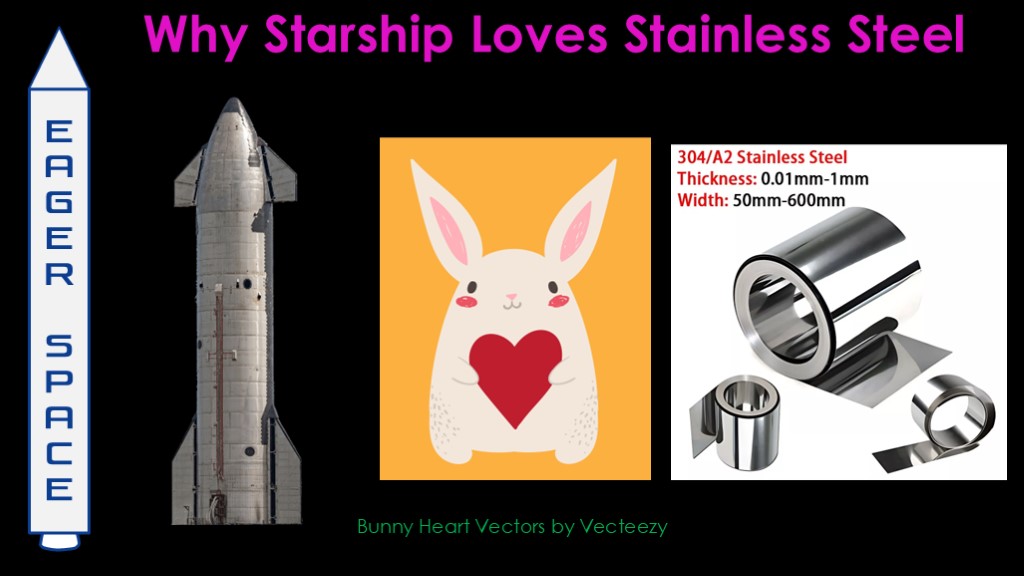
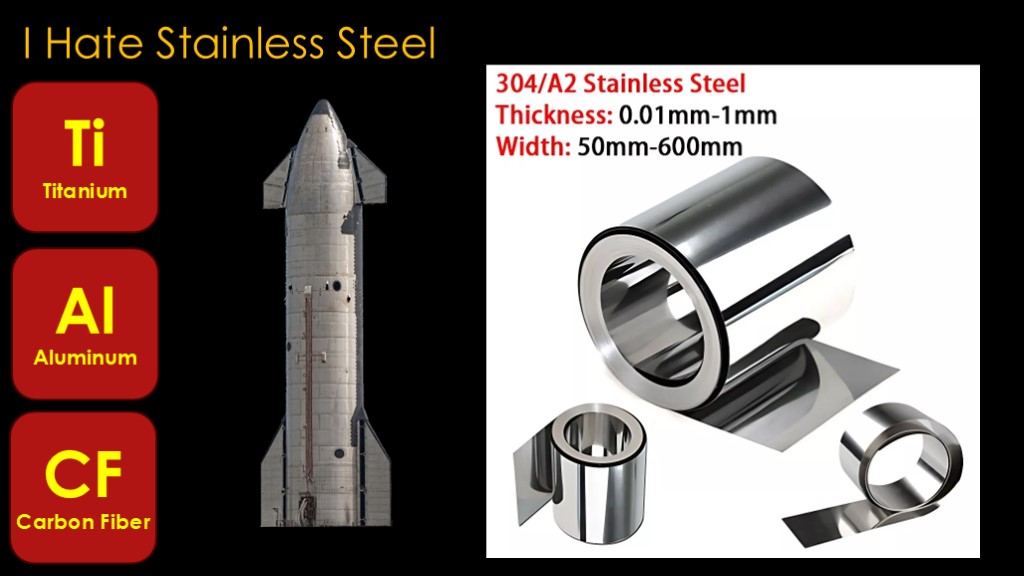
I've had many people ask about using other materials than stainless steel on starship.
The three options that are commonly mentioned are titanium, aluminum, and carbon fiber.
Note that for titanium and aluminum I'll be talking about alloys, and different alloys behave very differently. I've tried to pick the most common ones used for aerospace but the specifications aren't always available.

The analysis I'm going to be doing will make a little more sense if you've watched my engineering tradeoff analysis video.
If you want to go watch it now, we'll wait for you here.
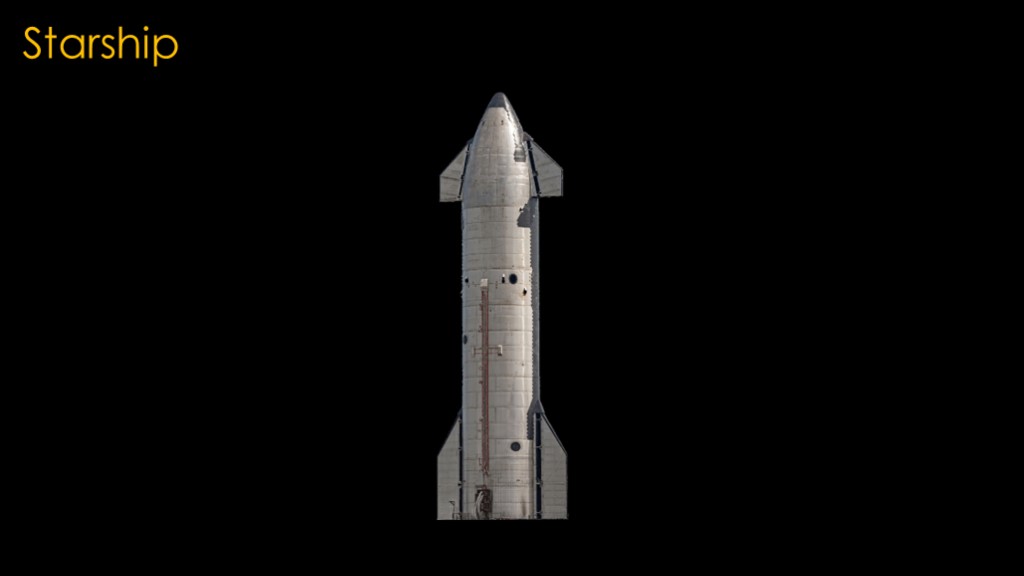
We'll start by talking about starship
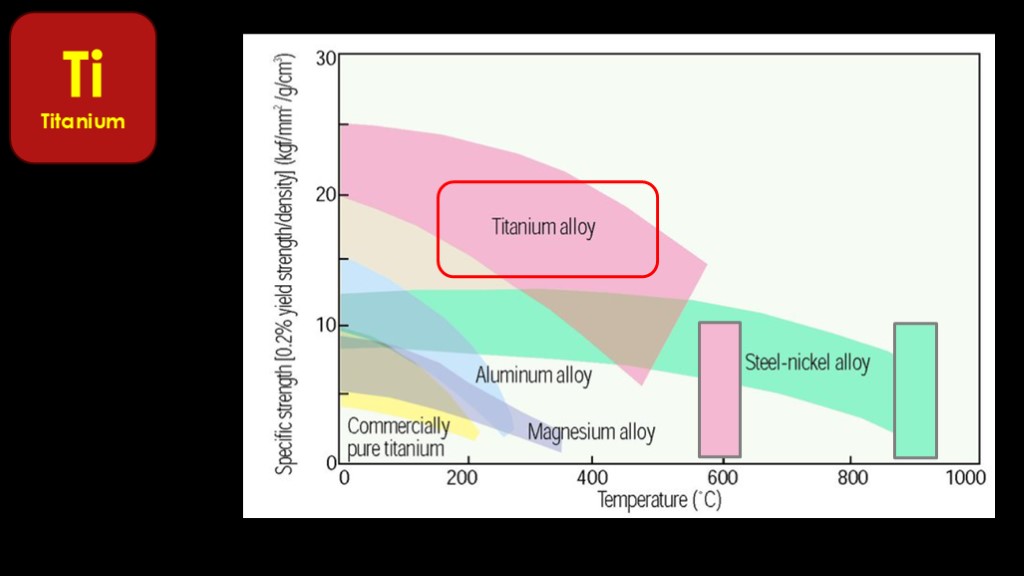
Titanium is our first candidate.
Titanium is widely reputed to be as strong as steel and 45% lighter but it looses that advantage at higher temperatures. 304 stainless is heat resistant up to about 870 degrees centigrade, and the best titanium alloys only go up to about 600 degrees. That is a significant disadvantage for starship because of reentry heating. You may be able to keep the titanium from getting too hot, but that will likely involve a heavier thermal protection system, which will likely negate any weight savings.
There are also issues with contamination in high-heat environments; under high heat, titanium wants to grab onto other elements and that can degrade its strength. You don't want a material that sees high heat and appears to be fine but actually has significantly reduced strength.
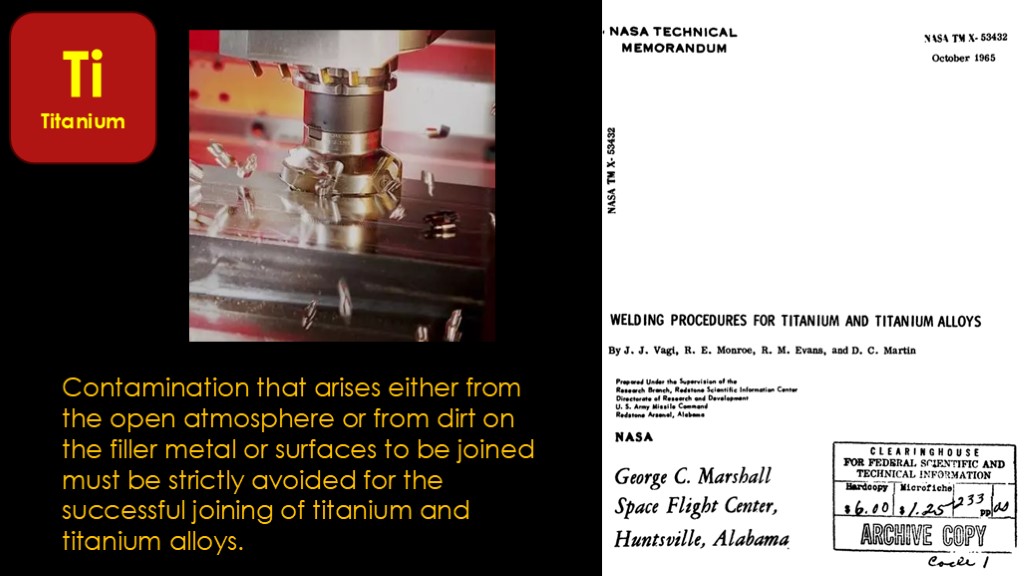
One of the sources I came across described titanium as "notoriously difficult to machine". Welding is possible, and NASA has a 236-page document that tells you how to do it properly. It says the following about the process
(read)
If you don't weld it exactly right, the impurities you get lead to embrittlement and the weld is not as strong as it should be.
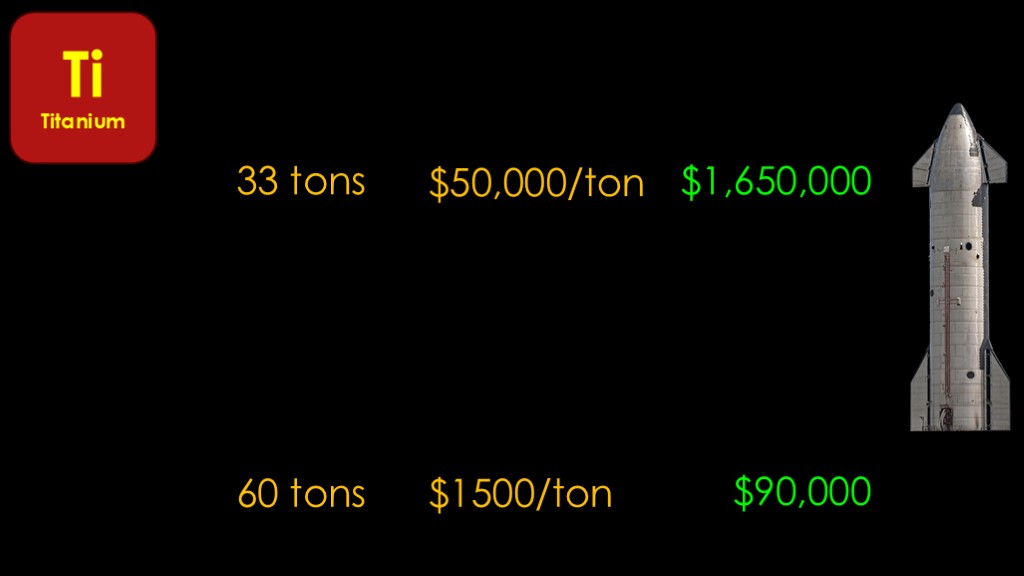
Cost is also an issue.
If we assume that starship has 60 tons of steel in it, we can make a guess at material costs.
I found suppliers of 304L stainless in rolls for $1500 per ton - I'm sure SpaceX pays less with the quantities they use - and that means that starship has about $90,000 of stainless steel in it
If we assume titanium is 45% lighter for a given strength - which many not be true at high temps, that would mean that we would need 33 tons of titanium
My research suggested that it would probably an alloy known as Ti-6A-4V.
It's hard to find prices for coils of titanium, but the the sources I checked suggest that it's $50 per kilogram, or $50,000 per ton. That's $1.65 million in materials, or over 18 times the cost of the stainless steel.
With stainless the material is cheap and machining and welding is well understood and therefore also relatively cheap. The titanium alloy is very expensive, machining is hard, and welding must be done very well or things break.
And, depending on the temperatures the material encounters, it may not be any better than stainless in terms of strength per kilogram, and overtemp behavior is probably worse. A titanium starship probably doesn't survive the IFT-4 reentry conditions.
If you know the heat environment really well and you are okay with the hassle of building with titanium, then I could maybe see using it, but I'm not excited about a less robust vehicle that is much much more expensive..

What about aluminum alloy? The biggest reentry vehicle before starship was made of aluminum and also used tiles to protect it during reentry, and all the big jetliners and many rockets use aluminum alloys, including SpaceX's own Falcon 9.
It's widely available, well understood and easy to weld and machine.
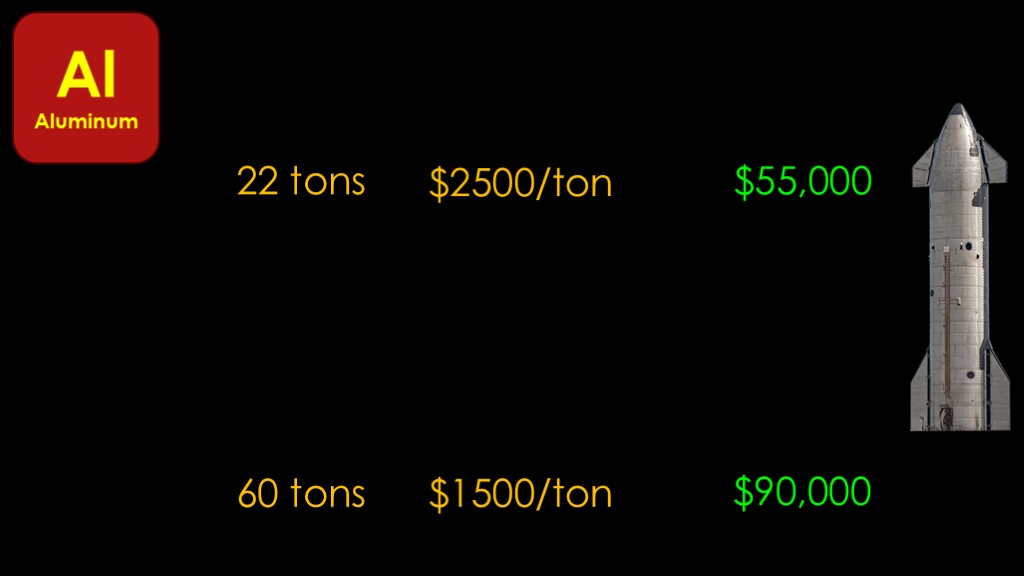
Starship would only require 22 tons of aluminum and its pretty cheap at around $2500 per ton, so it would be a little cheaper than stainless.
There are good reasons that aluminum is so widely used in aerospace
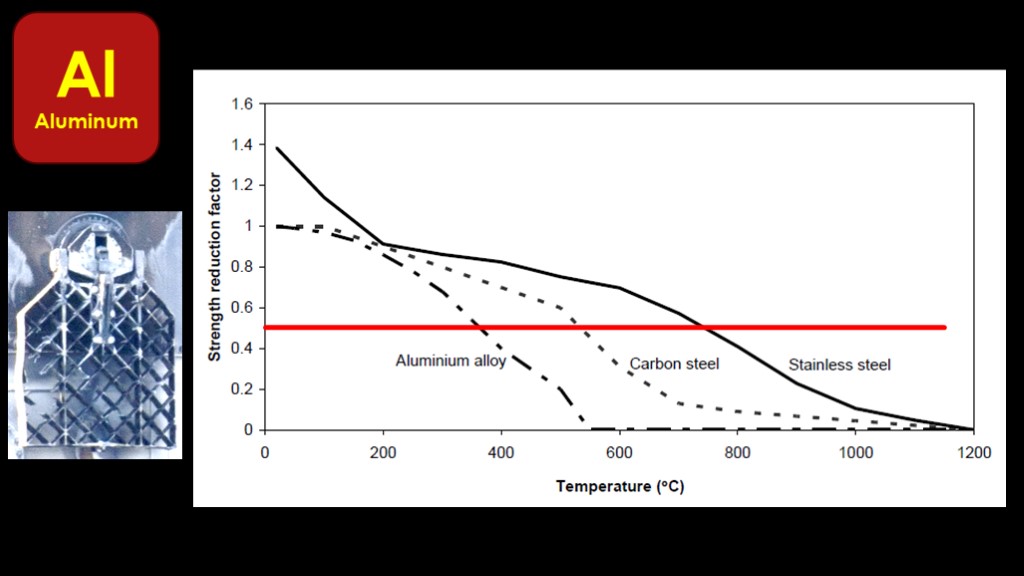
And here's the problem with aluminum for starship. The red line shows the point where a material has lost half of its strength. We see that stainless has 50% of its strength up to about 800 degrees centigrade.
Aluminum alloys lose half their strength before the temp reaches 400 degrees. Any issues with your thermal protection system and your structure melts away. In fact, SpaceX originally flew aluminum grid fins on the Falcon 9 but they had a tendency to melt even with the relatively small amount of heating experienced by the booster.
Not a great material for the high temperatures that come with reentry. The fin that survived the OFT-4 flight would have melted off the starship body very early in reentry and the vehicle would not have survived.

Which brings us to carbon fiber.
Back before the name "Starship" existed, SpaceX called their project BFR, and it was going to be full carbon fiber. SpaceX had two tank domes made and put together into this short tank, and they had this full-sized mandrel built that would be used to wind carbon fiber on to build the straight sections of the tanks.
So, somewhere, there is a design for how to build a starship-class vehicle out of carbon fiber.
Which is interesting...
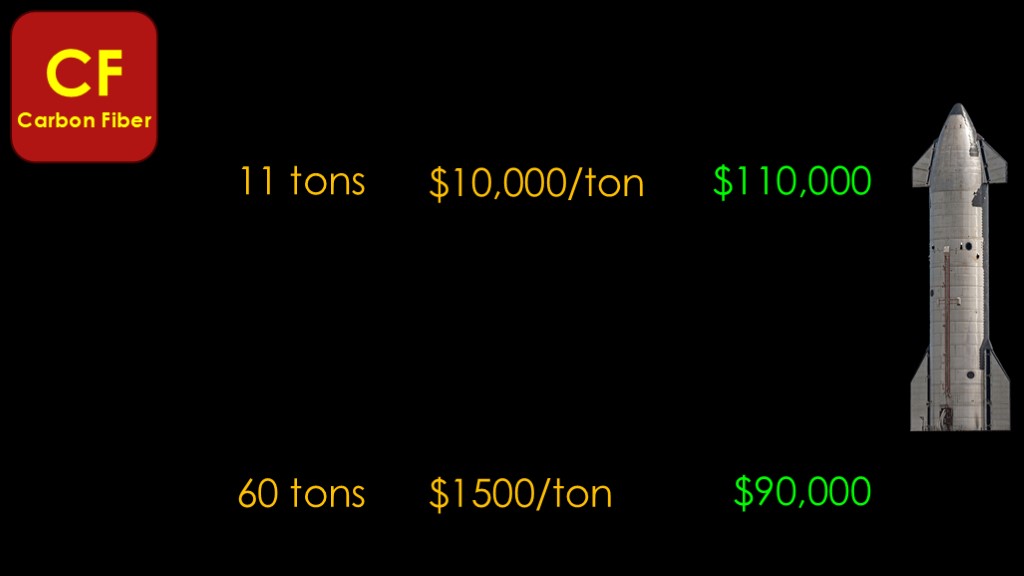
Carbon fiber is nice and light, so you likely only need 11 tons of it, and even at a relatively pricey amount of $10,000 per ton, that's $110,000 in materials.
That seems promising.

There are three big issues with carbon fiber for starship.
The first is that it has terrible high temperature properties; it loses about half its strength when it gets up to boiling water temperatures, or only about 100 degrees centigrade. There may be versions of carbon fiber that are more robust, but it is essentially very strong fibers held together by plastic or epoxy
You would need to have a really good thermal protection system to keep it cool enough, though it is fair to note a carbon fiber starship is going to be very light, which means a lot less energy in orbit and therefore a lot less heat to deal with.
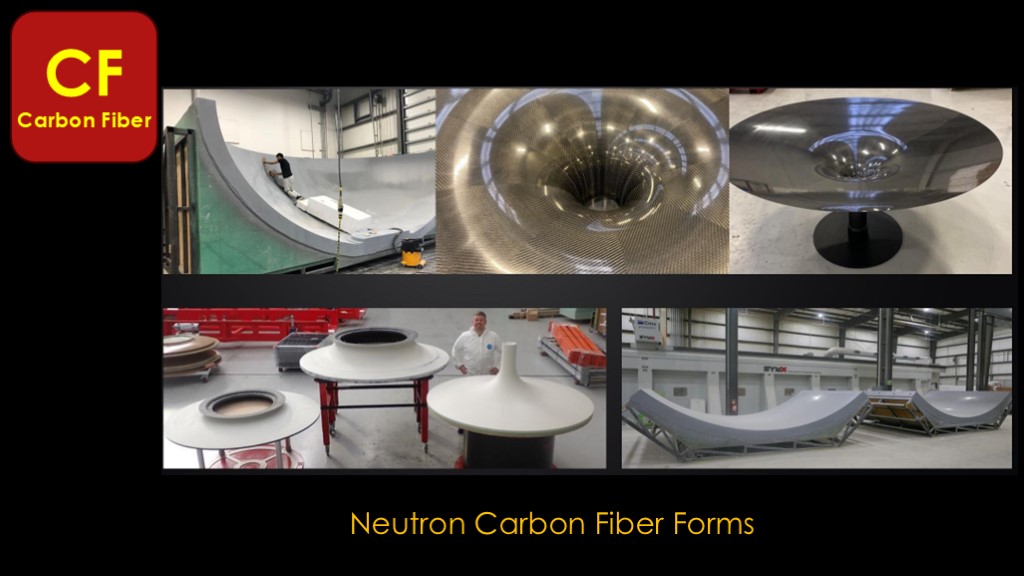
The second issue is that you have to build molds that the carbon fiber is applied to, and it is those molds that define the shape. Creating the mold takes a lot of time and money, and it's therefore not well suited when you aren't sure what you are building. Steel is great for that - if you want need more reinforcements in a section, you can just weld it in. If you need to mount new equipment, just weld it in. If you need a tank to test, just build a short version and you can test it, and go on.
This is a huge disadvantage if you aren't sure about what sort of design will work, which is certainly the case for starship.
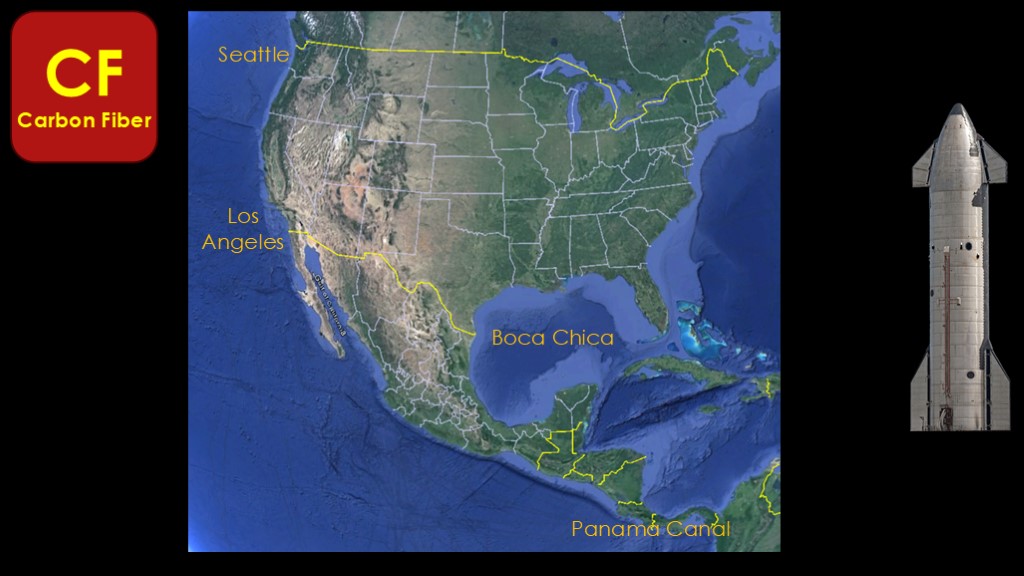
The third issue was the logistical aspects of the plan.
The plan was that they would build large carbon fiber tanks and other sections in seattle, ship them to LA to build the vehicles, then - presumably - ship them through the panama canal and then up to boca chica for testing.
The logistics would have been absolutely horrible - the cycle time would have been long and with making new molds to make changes, development would have been slow. Carbon fiber is absolutely the wrong choice if you don't have a design you know will work, especially if you aren't building your rocket at your launch site.
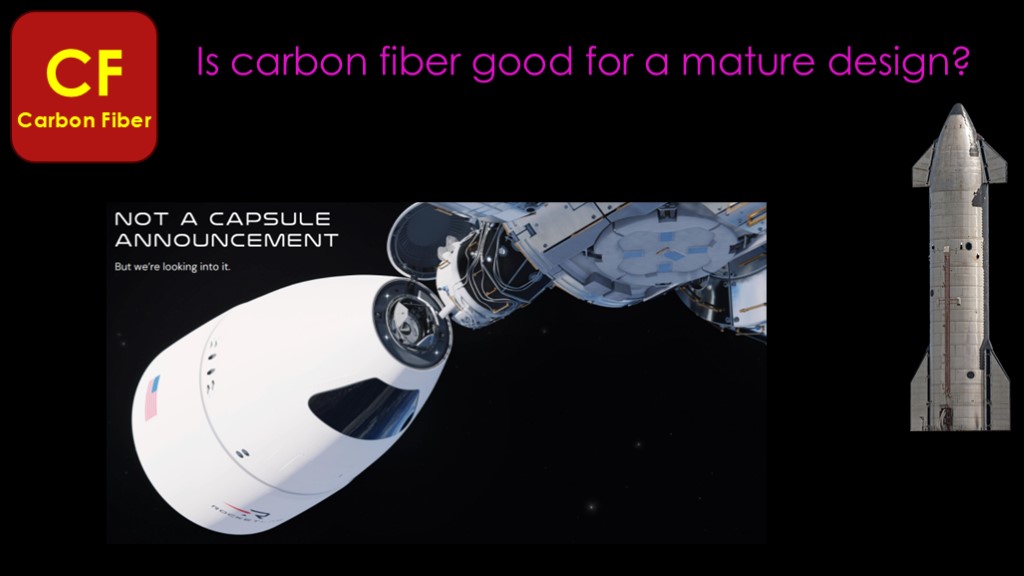
Would carbon fiber work with a mature design, one that is already thoroughly debugged?
I guess I can maybe see it, but SpaceX is not loaded with carbon fiber expertise right now and they are investing a large amount of money to be able to build a lot of starships out of stainless. Switching to carbon means that they need to rewind their development process back a few years and build a new factory, and that seems unlikely.
What I've wondered about is whether they'll consider a smaller vehicle for crewed flight. You can fly people on starship, but you don't need a 150 ton payload vehicle for LEO flights. Even if starship is very cheap, there's probably a niche for a Falcon 9 / Crew Dragon replacement, and that might be a carbon fiber solution.
Or maybe Rocket Lab jumps up to do that, since they're the carbon fiber experts.
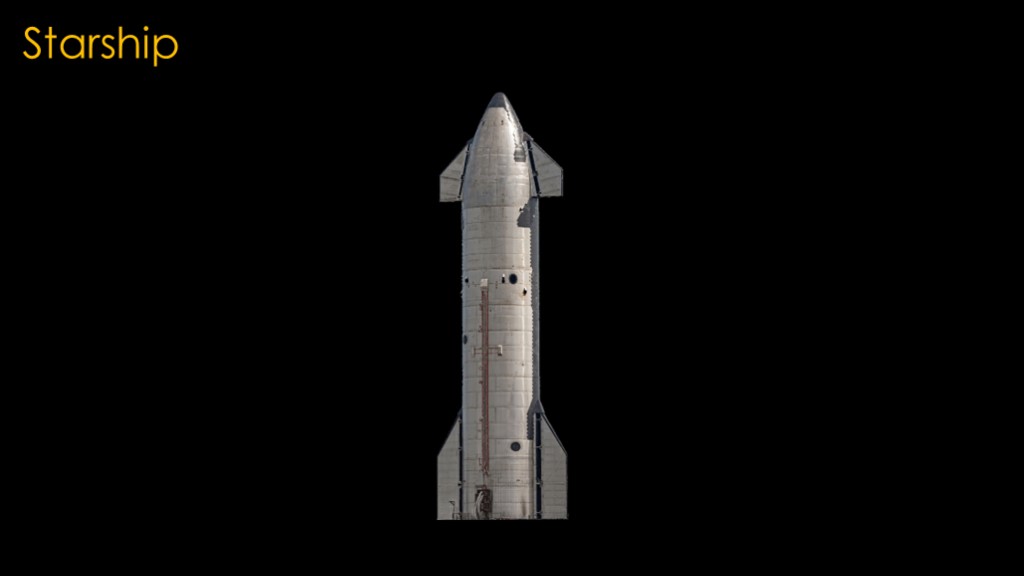
Stainless steel is a great material for starship. It's heavier than the other options but none of the other materials have the combination of high heat performance, ease of construction, and low cost.
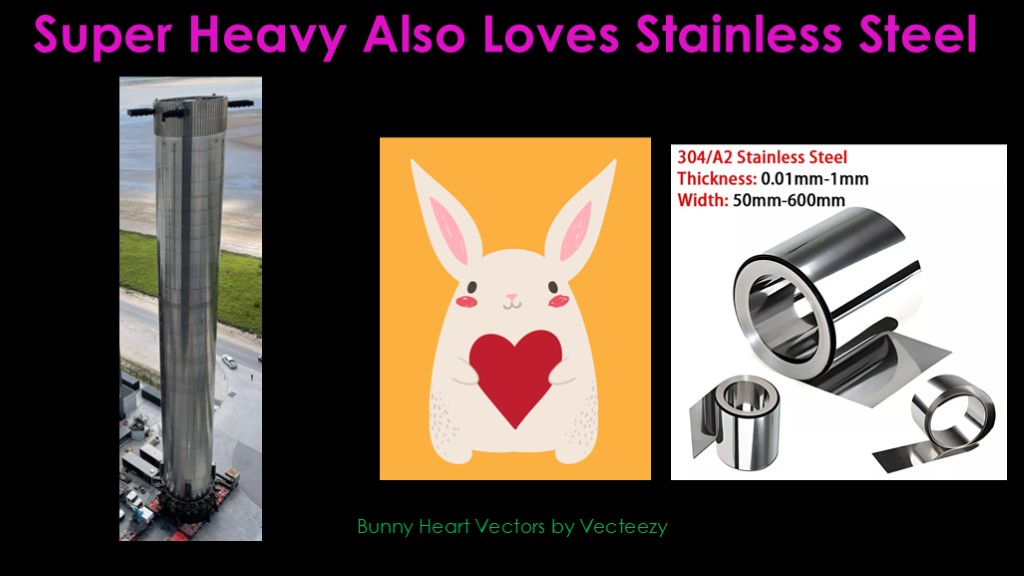
But super heavy also loves stainless steel.
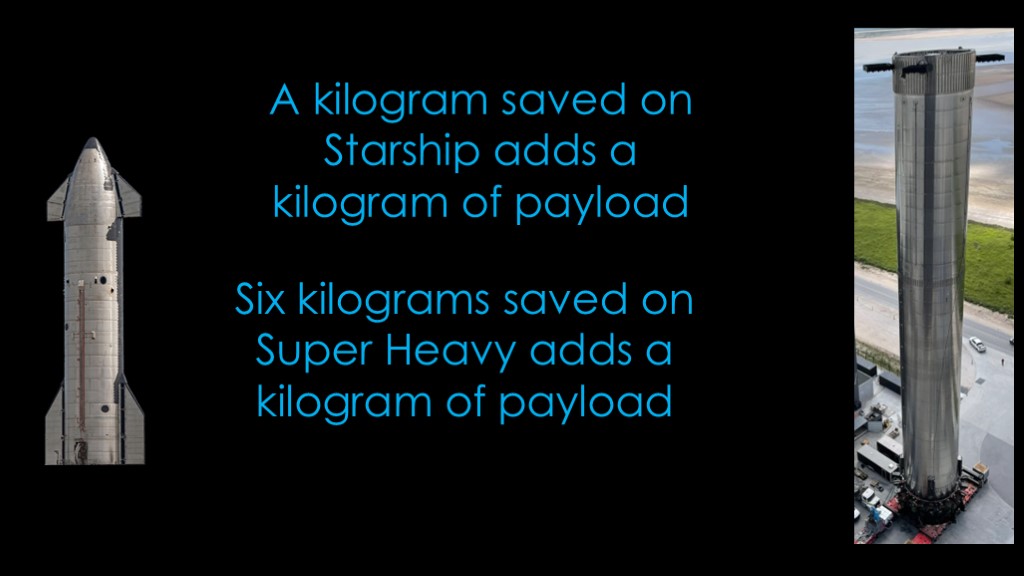
Before we talk about materials for super heavy, we need to cover one very important point.
When we are talking about second stages like starship, saving a kilogram of mass adds a kilogram of payload, and therefore second stage mass is very important. That is the biggest issue with the current Starship 1 design - it simply has too much mass.
That is not true for boosters. As a rough rule of thumb, you need to save about 6 kilograms of mass on the first stage to add a kilogram of payload to orbit.
That makes lighter materials much less interesting for first stages, but it's still worth looking at.
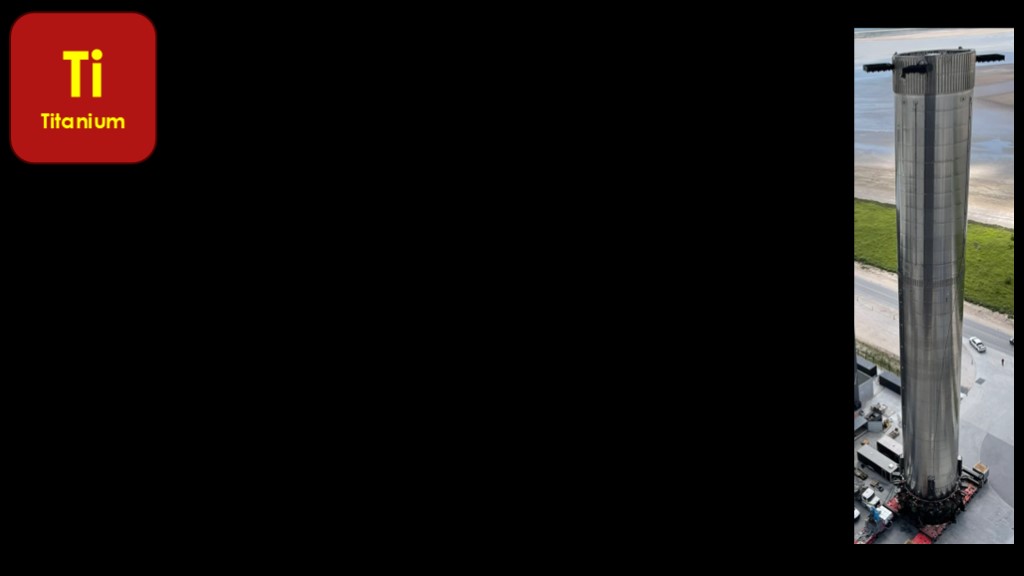
I see very little reason you would want to build a booster out of titanium. It's a lot of extra money and hassle for what would probably be small gains.
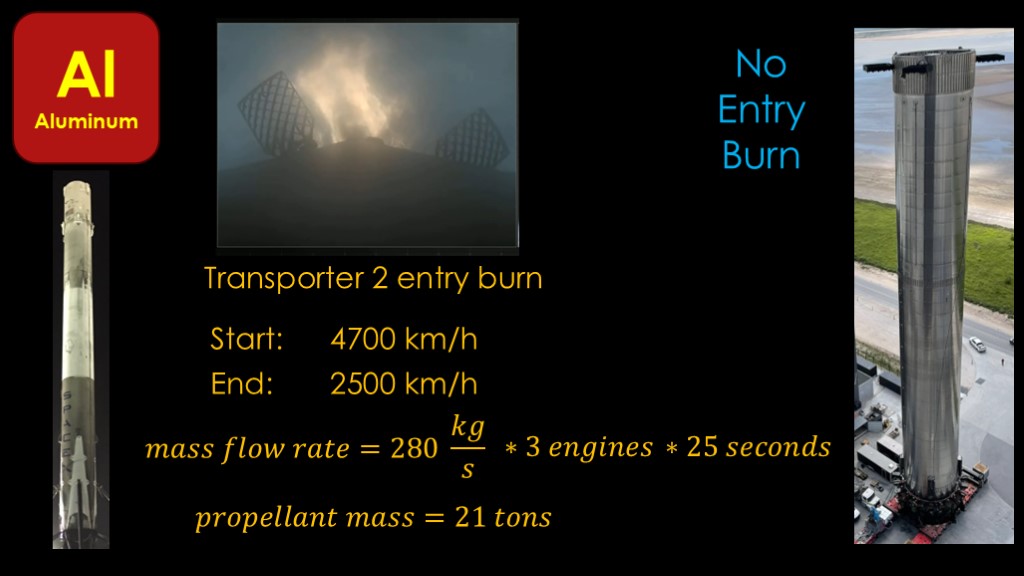
Aluminum is more interesting; it's cheap enough that you could afford to do it.
We know that the Falcon 9 booster is made of aluminum and it survives reentry, but we also know that it needs an entry burn to reduce its velocity and that super heavy does not do an entry burn.
That means there is penalty that the Falcon 9 pays because it's made of aluminum. Let's see if we can quantify it
On the transporter 2 launch, the booster was travelling at 4700 kilometers per hour at the start of the burn and only 2500 kilometers per hour at the end. That burn takes off about half the velocity of the stage and therefore about 75% of the kinetic energy.
We can do some rough math on the cost of the burn.
The merlin burns about 280 kilograms of propellant every second and this burn is 3 engines and goes for 25 seconds. That means it burns about 21 tons of propellant.
That 21 tons is about 70% of the empty mass of the booster. If we scale that up to super heavy masses, that's going to be a lot of extra propellant and my guess is that the extra propellant masses as much as the mass savings you would get with the lighter structure of aluminum.
So aluminum is also unexciting for super heavy.

Carbon fiber will follow the same pattern as starship, right?
Well, not quite.
The first stage of rocket labs neutron will be made fully from carbon fiber, and carbon fiber is roughly 5 times stronger than steel in terms of mass, so neutron might be only 20% the weight of a stainless steel rocket the same size.
That means that it is - to use a technical term - a lot more "floaty" than a stainless rocket, and that means it will come down more slowly and experience a lot less heating during reentry. Rocket lab believes that it will survive without an entry burn.
It's a fairly sure bet. Rocket lab has recovered their electron booster - also made of carbon fiber - without an entry burn, and SpaceX regularly recovers the falcon 9 fairings without entry burns.
So it's likely practical to build a super heavy out of carbon fiber.
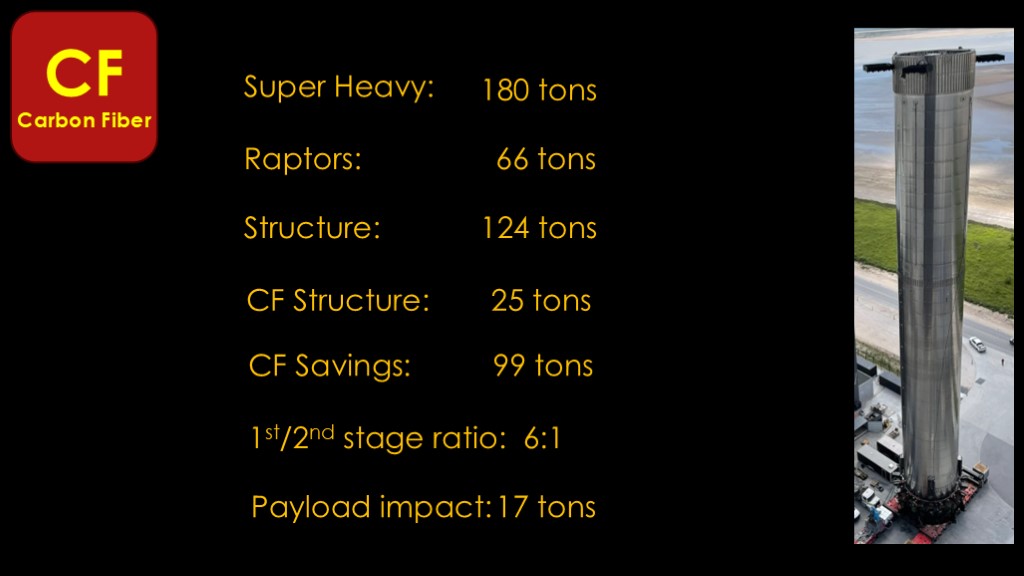
But does it make sense to do so?
Let's do a little math. My usual disclaimer applies - I'm going to make a lot of simplifying assumptions, so the numbers will be wrong but the overall answer will be correct in spirit.
I'll start by assuming that super heavy has a mass of 180 tons empty. It has 33 raptors, which are probably a couple of tons each, so that's 66 tons of raptors. That leaves us with 124 non-raptor tons.
And let's just assume that all of that is structure made out of stainless. It's not, but that will give us an upper limit. If carbon fiber is 20% the weight of stainless steel, that gives us a mass of carbon fiber structure of only 25 tons, a savings of 99 tons.
That is huge. Nearly 100 tons lighter.
*But* we have to remember that it takes roughly 6 kilograms of weight reduction on the first stage to get an extra kilogram of payload to orbit, so we divide that by 6 and get an expected payload impact of 17 tons.
That's a whole lot of investment to build a brand new factory to end up with only 17 tons of extra payload.
So I'm going to say "yes, you could do this, but I think there's pretty much zero chance spacex will do it". It's just not worth the effort.
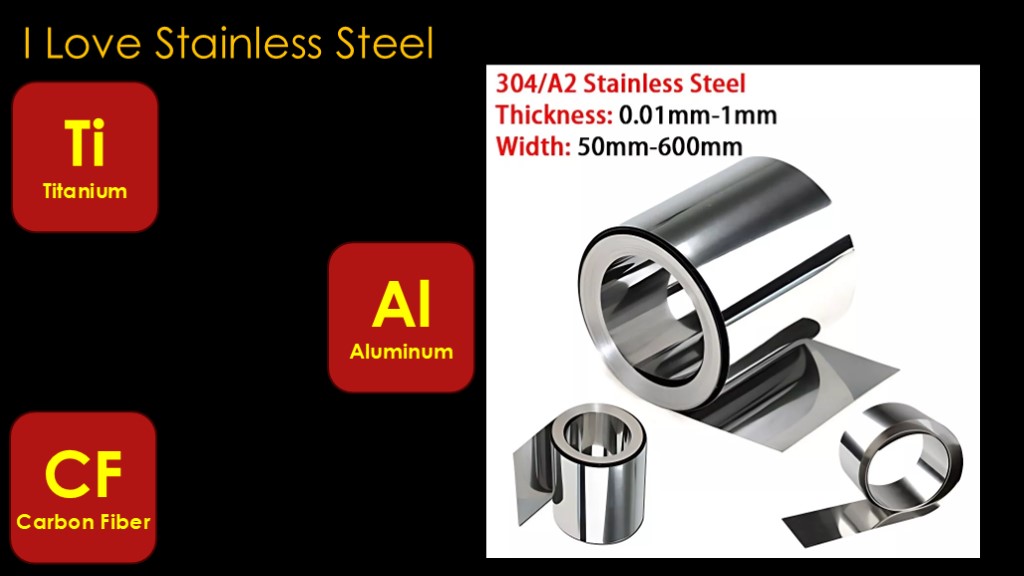
In summary, I don't find the other materials compelling enough to make them worth it, and I expect that SpaceX will stick with Stainless for starship.
If you look at scenarios where starship isn't coming back to earth, then alternate materials look a lot nicer, but the amount of work to build a factory to create them and test flights to verify that they work seems unlikely to be worth the cost. Easier to just stick with the normal starship and just fly more flights. Propellant is cheap.

If you enjoyed this video, I need me some tops. I'm obviously especially interested in the stainless steel ones.